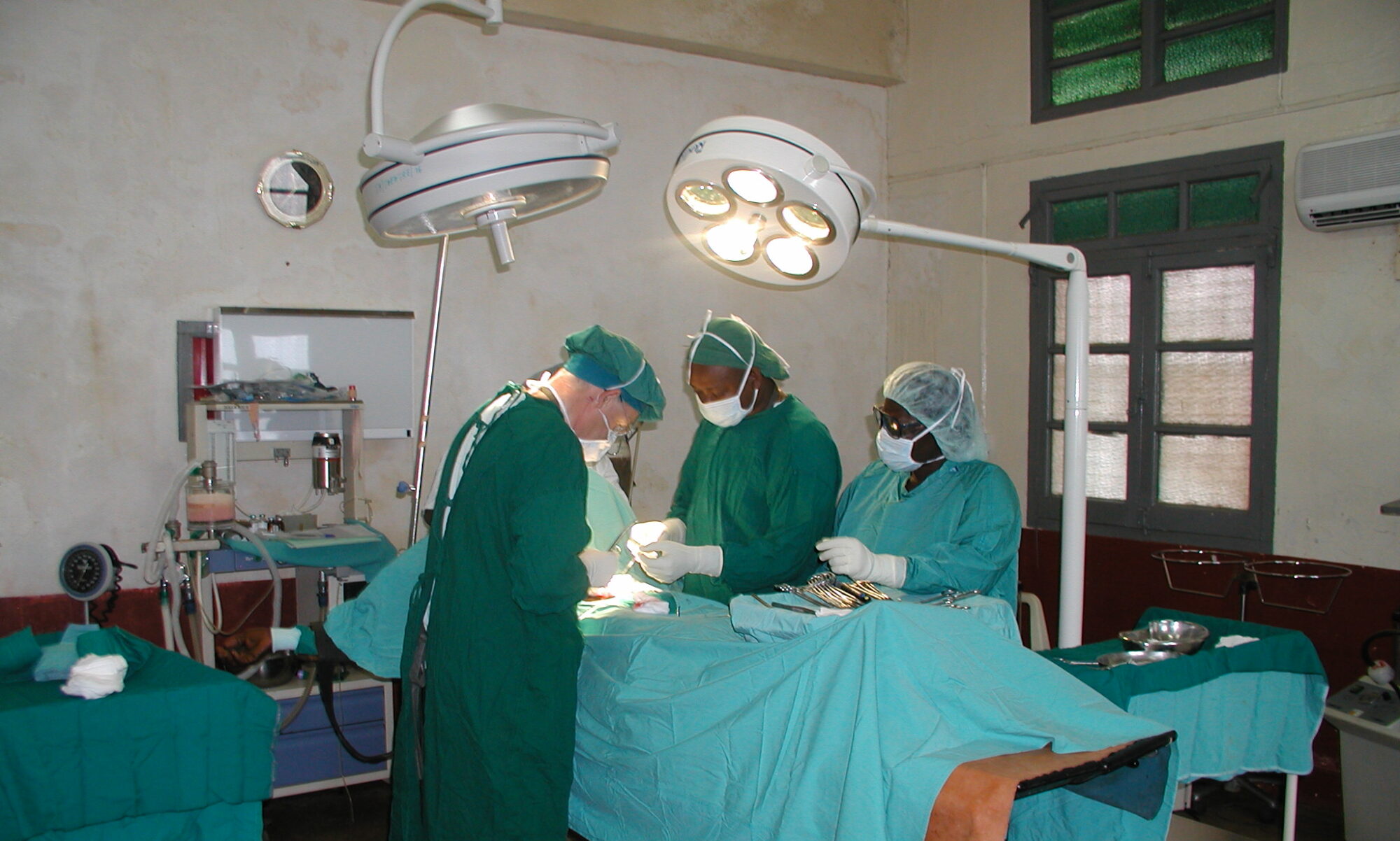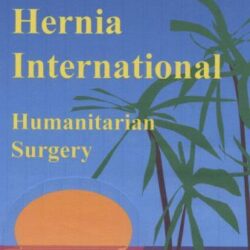
CAMPAIGN IN EMIRATES HOSPITAL. BOPOLU CITY, LIBERIA FEBRUARY 1-11, 2024
-TEAM
Second Surgeons in Action campaign, in conjunction with Hernia International, taking place in the city of Bopolu, Gbarpolu County, Liberia. It was scheduled for the end of 2023, but was suspended due to the proximity of local elections, which finally passed without problems.

Bopolu is a small town in Liberia, capital of Gbarpolu County. Emirates Hospital provides
healthcare to a population of 55,000 inhabitants. The local network has 14 basic health clinics, provided with midwives, but the hospital is responsible for all medical, surgical and obstetric
care.
Local coordination, as in previous campaigns, was carried out by Dr. Peter George, County Health Officer of Gbarpolu County, a local surgeon very involved in assisting and improving the conditions of his hospital and its neighbors.

The surgical team is made up of 12 volunteers:
-Laura Baumgartner Lucero. Anesthesiology. Burela (Lugo)
-Rocio Díez Munar. Anesthesiology. Madrid.
-Pilar Murga Pascual. Anesthesiology. Badajoz.
-Carlos Delgado Miguel. Pediatric Surgery. Madrid.
-Sara Ramallo Varela. Pediatric Surgery. Santiago de Compostela
-Lucía Corrales Fernández. Nurse. Burela (Lugo)
-Maria Jesus Nieto Berrocal. Nurse. Badajoz.
-Monica Ruiz Maleno. Nurse. Almeria.
-Monica Torres Díaz. General Surgery. Cee (A Coruña).
-Estefania Villalobos. General Surgery. Mexico.
-María Quirós Rodríguez. General Surgery. Burela (Lugo)
-Antonio Satorras Fioretti. General Surgery. Burela (Lugo). Coordinator.
The facilities for carrying out administrative procedures on the part of the Liberian Consulate in Madrid were scarce, and on the part of the Liberian Embassy in Paris, non- existent.
We provided a total of twenty-four suitcases of material collected by the volunteers and medication (donated entirely by the Hospital Publico da Mariña of Lugo), weighing 550 kg (two of 23 kg per volunteer).
The departure was on Thursday, February 1 at 6 p.m. from Madrid, with Royal Air Maroc, on a flight with a stopover in Casablanca, a technical stop in Freetown (Sierra Leone) and arrival in Monrovia, two hours late, at 6 a.m. Friday February 2nd. There we discovered the loss of four suitcases of material (one of them with a third of the medication) and the breakage of another.
After the claim procedures, we began the trip aboard three official vans, with a stop at the A La Lagune hotel for breakfast. Then, five and a half hours for 250 miles of travel along roads packed with cars, motorcycles and tuc-tucs, which are transformed into dirt tracks, with more potholes than ground.
After a difficult journey, we arrived in the afternoon at the town of Bopolu, where we were offered a warm welcome by the local population, with endless dances and speeches. Later the material was unloaded and prepared in the hospital facilities to start the next day.

-ACCOMMODATION
*HOTEL
The Lorine Guest House is a hotel that is very close to the hospital. It offers spartan single rooms with mosquito nets, acceptably clean, filled with mothballs to repel insects. They lack running water, so each bathroom has a large basin with auxiliary buckets for washing and using the toilet. Power only runs at night and plugs are compatible with European ones, so no adapters are required.
At night, on the patio, they have cold beers to spend a relaxed time. Collect and wash personal clothing was offered.
*FOODS
-Breakfast and dinner at a location between the hotel and the hospital. Food was based on
vegetables, rice, chicken, eggs and tilapia, all spicy. Various fruits. -Lunch: they bring something frugal and fruit to the hospital. -Water always available. Beer at dinner.
*INTERNET
Connection was offered by the coordinator with a local router that we had with us.
Frequent network loss, but it could be used every day

-HOSPITAL
Emirates Hospital is a new building with 150 beds. It has shared rooms for men, women and children, without air conditioning and poor hygienic conditions of beds and treatments. There are modern facilities but they are not functional (they have an ultrasound, a CT scan or computer equipment that have never been used). The main problem is the absence of supplies and replacements.
Electricity depends on solar panels and is only available from 9 a.m. to 9 p.m. Surgery cannot start earlier and there is no provision to extend the day.
We had a large operating room with air conditioning and a respirator that uses Isoflurane (and could work with Sevorane if available or carried). In that operating room a second table was set up for regional anesthesia. In an adjacent room without an O2 connection (a concentrator is used) a third table was installed. No overhead lamps (there are, but they don’t work). Acceptable lighting with auxiliaries and in some cases with frontals.

A large unequipped resuscitation room was used as a warehouse for storing materials and medications and as living room Problems in the supply of O2. Leak in the main tanks not repaired and absence of spare portable cylinders.
In addition, there was another operating room – which we did not use – used by the local team for cesarean sections with a respirator without O2 intake. It could use Halothane or Isoflurane in pressure control.
Despite their commitment to provide two electric scalpel consoles, we only had one and it worked wrong. Fortunately it was supplied with the two generator we had brought from Spain.
Only very basic boxes for hernias were available (we carry 2 adult hernias and 2 pediatric
hernias). Sterilization in a small steam autoclave in the surgical area itself was at least rapid
although very limited.
There was a minimal laboratory (hemoglobin, glucose, serology). The scheduled patients had previously been tested for HIV, hepatitis B, malaria and syphilis. If needed, there was the possibility of a blood bank.

The staff, who are largely volunteers, are quite disorganized. Difficulty in knowing the location of each patient, whether it is pre- or postoperative or whether it requires special attention. The medical records must be marked to avoid repeating patients.
The commitment to provide surgical gowns and drapes was initially fulfilled until stocks of sterile material were exhausted. At that time we were offered non-sterile examination gowns (insisting that this is what they use there) that did not meet the minimum conditions of asepsis. Thanks to the experience and expertise of our veteran nurse María Jesús, the material could to be sterilized, which allowed the campaign to be completed.
The training of local personnel was scarce, with hardly any medical personnel attending our daily activities. Auxiliary personnel were trained in material sterilization techniques.
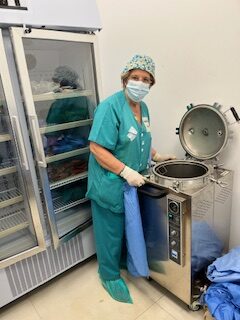
-DAILY ACTIVITY
At 7:50 a.m we met in the hotel courtyard to walk in five minutes to the place (a fenced warehouse) where they served us breakfast. In another ten minutes we walked to the hospital around 9 a.m.. We changed and did the first visit with the headlights until the light came on. It was then when the operating room began to activate and surgery was started around 9:30.
During the morning and afternoon, with a brief break for eating, three tables were non- stop
operated. In addition, patients previously selected by the local team were assessed and daily programming was carried out. On the third day, some patients who were scheduled for follow-up were reviewed. In addition, discharges were given providing doses of analgesia for the immediate postoperative period.
It didn’t end before 8pm, occasionally extending the day until the power went out. If we could, we took the opportunity to shower in the hospital itself. Later we returned by car (the lighting was non-existent and we were not advised to go walking) to the place where we had dinner and then to the hotel, where we took advantage of some time to relax with a cold beer.

-SURGICAL ACTIVITY
During the campaign we worked for seven days, in morning and afternoon shifts with a short break in between, on three simultaneous surgical tables. 173 patients have been operated on, with a total of 223 procedures, which makes an average of eight patients per table per day.

*ADULTS:
A total of 131 adults, 97 men and 34 women, aged between 16 and 80 years. In 22 cases they had several associated pathologies, so 153 procedures were performed.
98 inguinal hernias have been operated on (17 inguinoscrotal, 12 bilateral, 11 recurrent and two emergency due to strangulation that did not require intestinal resection although an appendectomy was required).
Other pathologies were umbilical/supraumbilical and epigastric hernias (11) and incisional hernias (4) for which mesh plaacement was mostly performed, hydroceles (11, two bilateral), large lipomas (22) and other soft tissue tumors (6 cysts and keloids).
82 regional anesthetics were used, 41 local with sedation and 8 pure local. Most patients were discharged the next day and no complications were recorded other than a hematoma that drained.
It should be noted that several patients were rejected, due to questionable diagnostic indication or anesthetic risk, who were later operated on by the local team, and whose evolution is unknown…
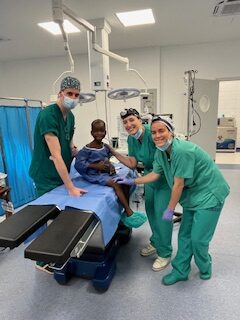
*CHILDREN
42 patients were operated on, 22 boys and 20 girls, aged between 6 months and 17 years, all under general anesthesia. In more than half, two or even three procedures were carried out, which raised the number to 72 procedures.
34 inguinal hernias (5 bilateral), 16 umbilical hernias, one hydrocele, two cryptorchidisms, one cord cyst, 4 circumcisions, 3 appendectomies (due to discovery of appendix in hernia sacs) and 4 soft tissue tumors (one of them a large cervical lymphangioma).
Furthermore, the two longest and most complex interventions were a pelvic burn involving the thighs, anus and genitals, and a burn with foot retraction. Both required laborious surgeries with skin grafts, with an initially very satisfactory result.
No significant complications were recorded. Two other cases of complex burns that had been scheduled were operated on without prior notice by the local team, to our great astonishment.
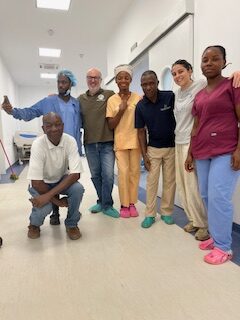
-RETURN
On Friday the 9th we finished the campaign, materials were collected and loaded into the cars. On Saturday morning there was a farewell event in the town hall, with a new session of lively and colorful local dances, endless speeches and delivery of thank-you gifts. Finally we left Bopolu and returned along another somewhat better but also heavy road to Monrovia.
Our idea was to do some sightseeing, but since the city offered nothing to see, we returned to the Hotel A La Lagune where we took some rooms that allowed us to use the pool, take a shower and rest for a while in the afternoon, before leaving. at 23:30 towards the airport. The night trip of more than an hour was bumpy, with one of our cars colliding although without any consequences.
The return flight took off on Sunday the 11th, delayed, at 4:30 a.m. and after making a stopover in Casablanca we arrived in Madrid at 6:30 p.m. without further incidents. A suitcase with a generator was lost, but luckily it turned up a few days later.
-BILLS
From the initial budget for accommodation, food and transportation that was proposed to us and seemed exaggerated by the forecasts, as it really was, a reduction of almost 50% was negotiated.
-Health Material: ……………………………………………………..……, Donation
-Medication:…………………………..…………………………..($ 1,635) Donation
-Visas: $100 per person……………………………………………..…………$1,200
-Madrid/Monrovia/Madrid plane tickets
960 ticket + 40 insurance: $1,000 per person………..………………..$12,0000
-Accommodation
*Bopolu: $25 per person per night (8): …………………………….……… $ 2,400
*Monrovia: $90 for a room of four and pool……………….…………………. $360
-Meal
*Monrovia Breakfast (10 $ x12)…………………………………………….…. $ 120
*Bopolu: $225 per person 8 days:……………………………………………$ 2,700
*Monrovia Food: ………………………………………………….………….… $ 215
*Various:…………………………………………………………………….….… $ 270
-Transportation: $50 per person…………………………………………… .… $750
TOTAL…………………………………………………………………….… .. $ 20,015 EXPENSE PER VOLUNTEER: $1,670
-PROPOSAL FOR NEXT CAMPAIGNS
The Emirates Hospital in Bopolu is a center well equipped to carry out surgical campaigns. There is a good selection of patients and the facilities are appropriate. Looking ahead to future actions, teams should make certain considerations.
-Absence of sterile conditions in their usual practice.
-Lack of gowns and cloths. Disposable sterile gowns were initially used (they were even cut down to use as a drape) until they ran out. Disposable non-sterile gowns were offered. They can be resterilized in an autoclave. Laundry and autoclave in the hospital. Consider bringing cloth material, if they can offer resterilization.
-Few surgical instruments. Boxes must be brought
-The agreed electric scalpel generators were not provided, so they must be brought.
-Anesthesia equipment that could work with Sevorane.
-A full-time nurse is needed to manage sterilization.
-Loss of luggage with Royal Air Maroc. Distribute materials/drugs to minimize the
consequences of loss.
